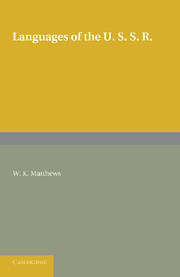Book contents
- Frontmatter
- Contents
- LIST OF ILLUSTRATIONS
- PREFACE
- Map
- Chapter I THE LINGUISTIC PATTERN
- Chapter II PALAEOASIATIG LANGUAGES
- Chapter III URALIAN LANGUAGES
- Chapter IV ALTAIC LANGUAGES
- Chapter V NORTH CAUCASIAN LANGUAGES
- Chapter VI SOUTH CAUCASIAN LANGUAGES
- Chapter VII INDO-EUROPEAN LANGUAGES
- Appendix I TABULAR SUMMARY
- Appendix II LANGUAGE STATISTICS
- Appendix III BIBLIOGRAPHY
- Appendix VI INDEX OF LANGUAGES AND DIALECTS
- Appendix V SYMBOLS AND PHONETIC VALUES
- INDEX
Chapter I - THE LINGUISTIC PATTERN
Published online by Cambridge University Press: 05 June 2016
- Frontmatter
- Contents
- LIST OF ILLUSTRATIONS
- PREFACE
- Map
- Chapter I THE LINGUISTIC PATTERN
- Chapter II PALAEOASIATIG LANGUAGES
- Chapter III URALIAN LANGUAGES
- Chapter IV ALTAIC LANGUAGES
- Chapter V NORTH CAUCASIAN LANGUAGES
- Chapter VI SOUTH CAUCASIAN LANGUAGES
- Chapter VII INDO-EUROPEAN LANGUAGES
- Appendix I TABULAR SUMMARY
- Appendix II LANGUAGE STATISTICS
- Appendix III BIBLIOGRAPHY
- Appendix VI INDEX OF LANGUAGES AND DIALECTS
- Appendix V SYMBOLS AND PHONETIC VALUES
- INDEX
Summary
As a linguistic mosaic the U.S.S.R. superficially resembles India. In either case we have a profusion of individual languages, several distinct groups or stocks distributed in a broadly similar fashion, a residue of isolated types, and an Indo-European (Aryan) lingua franca, whose lines of expansion run mainly eastwards and southwards. But apart from the ubiquitous Indo- European, none of the other stocks occurs in both countries: North Caucasian, for instance, is as typically Soviet as Dravidian is typically Indian. Bishop Robert Caldwell's correlation of Dravidian with Uralian (his ‘Scythian’) in 1856, still retained by J. L. Wyatt and T. R. Pillai in their revision of the third edition (1913) of his standard Comparative Grammar of the Dravidian or South-Indian Family of Languages, has rarely been taken seriously by competent linguists, and the more recent hypothesis propounded by the Hungarian scholar W. Hevesy, that Uralian is ultimately cognate with Kolarian (‘Mundā-Sprachen’), carries as little conviction as Father W. Schmidt's Austric theory, connecting Austroasiatic (including Kolarian) with Austronesian, which it is designed to refute.
The U.S.S.R. has five language stocks—Uralian, Altaic, North Caucasian, South Caucasian, and Indo-European—each with a genetic basis, and a language complex tentatively called Palaeoasiatic, which comprises related and evidently unrelated languages placed together on geographical grounds and because of a vague general resemblance in sound and structure. The linguistic pattern of the country may be represented geometrically as follows: a central wedge of Indo-European (Russian) divides a northern, Uralian zone from a southern, Altaic zone, and tapers off towards an eastern, Palaeoasiatic rim, while the mountainous isolation of the Caucasus in the south-west harbours two individual and territorially compact stocks—North Caucasian and South Caucasian—and, like the Pamirs farther east, preserves some ancient fragments of Indo-European.
Information
- Type
- Chapter
- Information
- Languages of the USSR , pp. 1 - 2Publisher: Cambridge University PressPrint publication year: 2013
